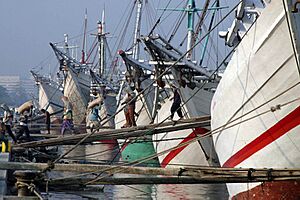Sunda Kelapa facts for kids
Quick facts for kids Port of Sunda Kelapa |
|
|---|---|
 |
|
| Lua error in Module:Location_map at line 530: Unable to find the specified location map definition: "Module:Location map/data/Yes" does not exist. | |
| Location | |
| Country | |
| Location | North Jakarta, Indonesia |
| Coordinates | 6°07′26″S 106°48′31″E / 6.123871°S 106.80861°E |
| Details | |
| Operated by | Indonesia Port Corporations |
| Type of harbor | Natural seaport |
| Land area | 50.8 Ha |
| Statistics | |
| Vessel arrivals | Hourly |
Sunda Kelapa (which means "Coconut of Sunda" in Sundanese) is a very old port in Jakarta, Indonesia. It sits right where the Ciliwung River meets the sea. This port was once the main gateway for the ancient Sunda Kingdom.
Today, Sunda Kelapa is a smaller port. It mostly handles pinisi ships. These are traditional wooden sailing boats with two masts. They are used to carry goods between different islands in Indonesia. Even though it's not as big as it used to be, Sunda Kelapa is super important. It's where the city of Jakarta first began! The port is currently managed by the Indonesian government's port company.
Contents
History of Sunda Kelapa
Early Times: Hindu-Buddhist Period
From the 13th to the 16th century, Sunda Kelapa was the main port for the Sunda Kingdom. The kingdom's capital, Pakuan Pajajaran, was about 60 kilometers inland. The port was a busy place for international trade. It was especially known for trading black pepper, a valuable spice grown in the Sunda Kingdom. Sunda Kelapa was one of the few Indonesian ports that traded directly with European countries.
Arrival of Europeans: Islamic and Portuguese Periods
In 1511, the Portuguese arrived in Southeast Asia. They took control of Malacca. A Portuguese explorer named Tomé Pires wrote about the importance of the port of Calapa (Sunda Kelapa) around 1512-1515.
In 1522, the Portuguese made a deal with the Hindu Sunda Kingdom. The king of Sunda, Prabu Surawisesa, allowed them to trade pepper freely. In return, the Portuguese promised military help against the rising Islamic Demak Sultanate. Some Portuguese people even settled in Sunda Kelapa. They were among the first Christians in what is now Indonesia.
However, in 1527, a leader named Fatahillah attacked the Portuguese at Sunda Kelapa. He was fighting for the Sultanate of Demak. Fatahillah successfully captured the port on June 22, 1527. After this victory, Sunda Kelapa was renamed Jayakarta. Later, the port became part of the Sultanate of Banten.
Dutch Control: VOC and Colonialism
In 1619, a Dutch official named Jan Pieterszoon Coen took control of Jayakarta from the Banten Sultanate. He then founded a new city called Batavia. This city is now Jakarta.
In the early days, the port was mostly used by smaller ships. These ships could sail into a canal and reach the Kali Besar area. Here, goods were loaded and ships were repaired. Larger ships found it hard to enter the port because it was narrow and shallow. They had to anchor further out at sea.
Over time, keeping the port clear became very difficult. Sandbanks kept building up at the mouth of the port. In the 18th century, the Dutch tried to use slaves and horses to clear the sand. But this method was not very good and caused many problems.
Modern Colonial Era and New Ports
During the 19th century, the port was known as the Haven Kanaal (Harbor Canal). It was the only way to get into Batavia by sea. But it was still a narrow harbor. Large ships still had to anchor far away. Smaller boats called "lighters" were used to carry cargo and people to the port. This process was slow and could be dangerous during storms.
Because of these problems, and with more ships coming after the Suez Canal opened, the Dutch government decided to build a new port. In 1885, the new Tanjung Priok port was built. It was located about 9 kilometers east of the old port.
After Independence: Sunda Kelapa Today
After Indonesia became an independent country, the old port of Batavia was given back its original name: Sunda Kelapa. This was done to honor its long and important history as the birthplace of Jakarta.
See also
- Jakarta Old Town


